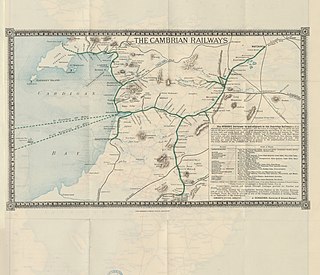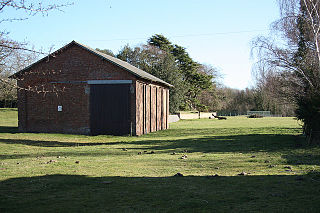
The Cambrian Railways owned 230 miles (370 km) of track over a large area of mid Wales. The system was an amalgamation of a number of railways that were incorporated in 1864, 1865 and 1904. The Cambrian connected with two larger railways with connections to the northwest of England via the London and North Western Railway, and the Great Western Railway for connections between London and Wales. The Cambrian Railways amalgamated with the Great Western Railway on 1 January 1922 as a result of the Railways Act 1921. The name is continued today in the route known as the Cambrian Line.

The Abermule train collision was a head-on collision which occurred at Abermule, Montgomeryshire, Wales on Wednesday 26 January 1921, killing 17 people. The crash arose from misunderstandings between staff which effectively over-rode the safe operation of the Electric Train Tablet system protecting the single line. A train departed carrying the wrong tablet for the section it was entering and collided with a train coming the other way.

Caersws railway station is a railway station on the Cambrian Line in mid-Wales, serving the village of Caersws. It is notable that there is a distance of 22 miles (35 km) between this station and Machynlleth, the longest distance between two intermediate stations in Wales.

Penrhyndeudraeth railway station is a railway station serving the small town of Penrhyndeudraeth on the Dwyryd Estuary in Gwynedd, Wales. It is a station on the Cambrian Coast Railway with services between Shrewsbury and Pwllheli via Machynlleth.

Hawkhurst railway station was on the closed Hawkhurst Branch in Kent, England.

Cranbrook railway station is a disused English station which was on the closed Hawkhurst Branch in Kent, England.

Whitchurch Town railway station was a station on the Didcot, Newbury and Southampton Railway in England. It served the town of Whitchurch, Hampshire, between 1885 and 1960.

Abermule railway station served the village of Abermule in Wales. Served by the Oswestry and Newtown railway, it was situated on the English border. Until 1956 it was the junction for the short branch to Kerry, which had a passenger service until 1931 but was largely built for the local timber traffic.

Aby for Claythorpe was a railway station on the East Lincolnshire Railway which served the hamlets of Aby and Claythorpe in Lincolnshire between 1848 and 1961. It originally opened as Claythorpe, but was renamed in 1885. Withdrawal of goods facilities took place in 1961, on the same day that the station was closed to passengers. The line through the station is closed.

Five Mile House was a railway station on the Lincolnshire Loop Line which served the village of Fiskerton in Lincolnshire between 1848 and 1964. Situated on the south bank of the River Witham, passengers on the north bank had to use a ferry to reach it. It closed two years after opening due to low traffic, but reopened fifteen years later. Passenger services were withdrawn in 1958, leaving the station open for anglers' excursions until 1964. The Water Rail Way footpath now runs through the site.

Burgh-le-Marsh was a railway station on the East Lincolnshire Railway which served the town of Burgh le Marsh in Lincolnshire between 1848 and 1970. It originally opened as Burgh, but was renamed in 1923. Withdrawal of goods facilities took place in 1966, followed by passenger services in 1970. The line through the station is now closed.

Alford Town was a railway station on the East Lincolnshire Railway which served the town of Alford in Lincolnshire between 1848 and 1970. It originally opened as Alford, but was renamed in 1923. When passenger services were withdrawn in 1970 the line through the station was closed.

Authorpe was a railway station on the East Lincolnshire Railway, which served the village of Authorpe in Lincolnshire between 1848 and 1964. The station was closed to passengers in 1961, and withdrawal of goods facilities took place in 1964. The line through the station is closed.

The Mid-Wales Railway was conceived as a trunk route through Wales connecting industrial areas in North West England with sea ports in South West Wales. The company was prevented from reaching its goal by competing proposals in Parliament, and it was only able to build a line between Llanidloes and a junction with the Brecon and Merthyr Railway 5 miles (8 km) east of Brecon. The line was 70 miles (110 km) long and opened in 1864. The company found it impossible to raise the share subscription, but the contractor partnership of Davies and Savin agreed to build the line and take shares in payment,

Witney railway station served the Oxfordshire town of Witney on the Oxford, Witney and Fairford Railway line. It consisted of two stone-built platforms, a station building, a signal box, and a shed in the form of a pagoda.

Carno is a closed railway station in Carno, on the Cambrian Line, that was part of the Newtown and Machynlleth Railway. The station was closed in 1965 as part of the Beeching Cuts though there are proposals to re-open it.
Hainton Street Halt was a railway halt on the East Lincolnshire Railway which served the Welholme Road area of Grimsby in Lincolnshire between 1905 and 1961. The station was opened as part of a new motor train service between Grimsby and Louth. The station briefly closed in 1939 as a Second World War economy measure, but reopened in 1940. The line through Hainton Street remained open for freight until December 1980. The trackbed was later reused by Humberside County Council to construct the A16 Peaks Parkway which now runs through the site. Building of the road put an end to the aspirations of the Great Northern and East Lincolnshire Railway plc to reopen the line as a heritage railway.
The Oswestry and Newtown Railway was a British railway company that built a line between Oswestry in Shropshire and Newtown Montgomeryshire, now Powys. The line opened in stages in 1860 and 1861. It was conceived to open up the area to rail transport, when local opinion formed the view that the trunk railway companies would not do so. Subscription money for the construction proved very difficult to generate. It was the action of a contractor partnership, Davies and Savin, in agreeing to accept shares as the majority of their payment for construction work, that saved the company from failure.

Bryngwyn Halt railway station is a disused station that was on the Llanfyllin Branch of the Cambrian Railways. It served the villages of Bwlch-y-cibau and Brynderwen between 1863 and 1965.

Llandinam railway station was a station serving Llandinam, Powys, on the Llanidloes and Newtown Railway (L&NR) line. The L&NR was authorised in August 1853; construction began in October 1855 and the line was opened between those points for goods traffic only on 30 April 1859 – passengers were carried from 31 August 1859. Llandinam was one of three intermediate stations on the 13-mile line. The station was opened in 1859 by David Davies who was born in Llandinam and was a major contractor for building the line. In July 1864 the L&NR amalgamated with three other railways to create the Cambrian Railways, which in January 1922 amalgamated with the Great Western Railway which itself became part of British Railways in 1948.

















